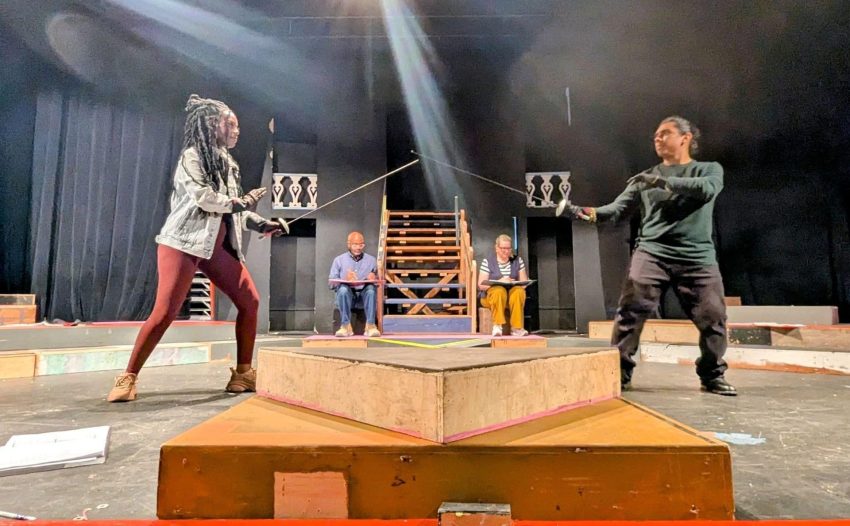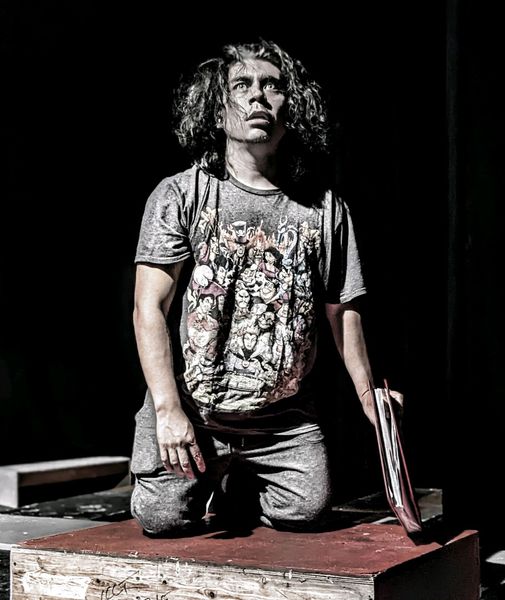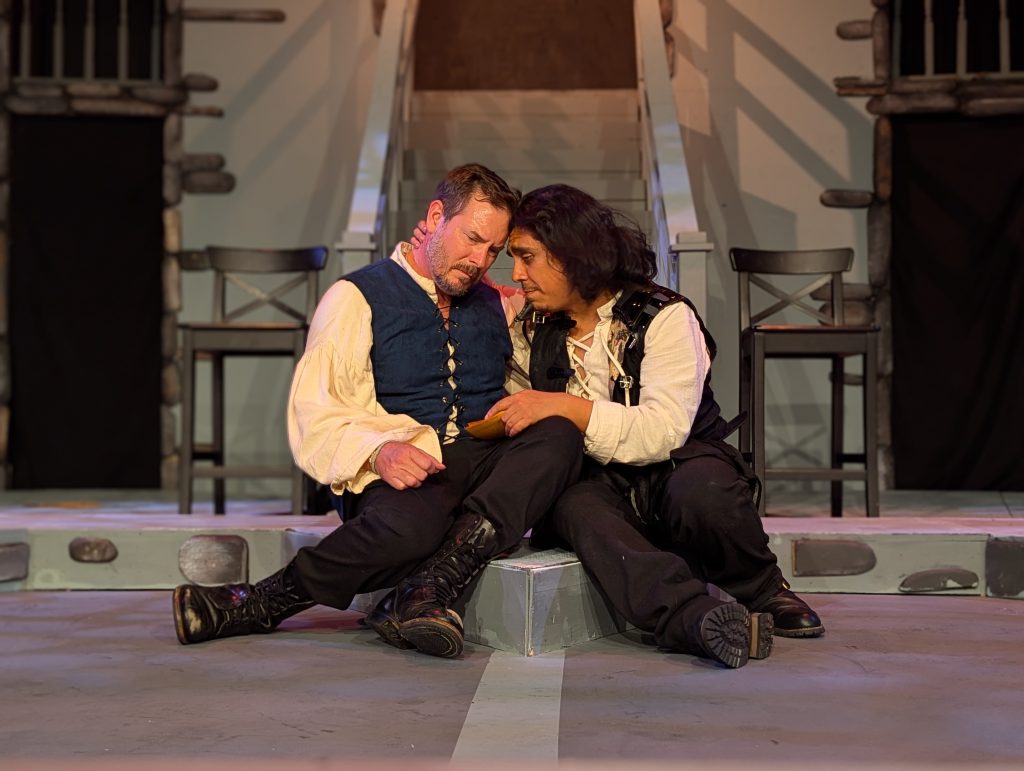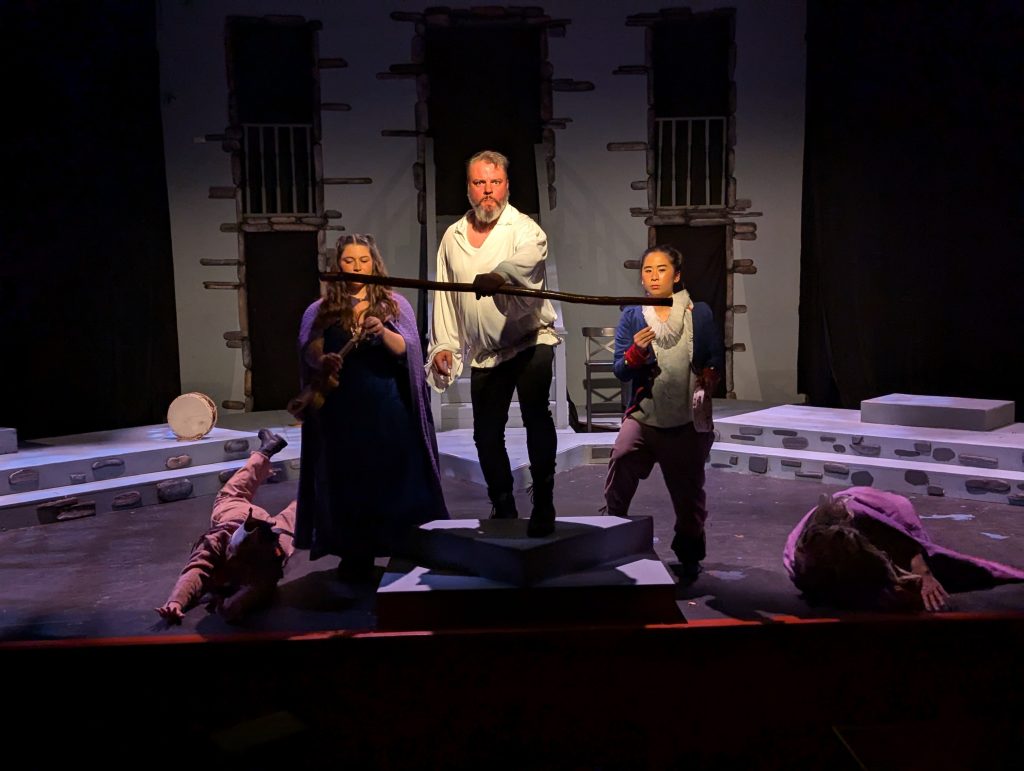
“Hamlet” & “R & G Are Dead”: Ambitious ‘Double Feature’—at CCCT
Director Joel Roster Flips a Coin in “R & G”—and Wins!
by Lynne Stevens
A dark, dark mood looms and dark deeds are being plotted.
Seeing Shakespeare’s “Hamlet” and Tom Stoppard’s “Rosencrantz and Guildenstern Are Dead” one day after the other with the same actors reminds us that bit players in life have a larger role than they think. All the world’s a stage and we do all have our parts.
An 80-year-old and a 20-year-old can both identify with Hamlet’s dilemma. One is facing the end of days; the other is anxious and unsure if life is worth living.
To be or not to be . . .
In “Hamlet,” the first of Contra Costa Civic Theatre’s double feature, we wonder how King Claudius can really be puzzled by Hamlet’s behavior. What would one expect? He’s grieving, he’s upset. That murder should be an aspect of statecraft is not only a driver of the plot, but also a reminder that the harsh King in “Hamlet”—and even more in “R&G Are Dead”—wields the power to kill his enemies. We don’t have that, but Russia does. And Trump admires Putin.
In Director Joel Roster’s “Hamlet,” Benjamin Rafael Garcia plays Hamlet, LaMont Ridgell plays Claudius, and Michaela Sasner plays Ophelia. While they are major aristocratic roles in Shakespeare, they play minor roles in Stoppard’s follow up 1966 existential comedy, “R & G Are Dead.”
The two plays are running on alternate days, so you can see the major roles flip the next day. The courtiers become secondary, and the minor characters leap to the major roles in “R & G.”
Shakespeare’s plays are always being altered and adapted. In this production, Laertes, Polonius’ son, is played by Raven Douglas, a woman. She becomes another daughter, a sister to Ophelia, a change that may be jarring to those who expect Laertes to be male.
Also, of note in “Hamlet,” Rosencrantz and Guildenstern are cipher courtiers, unimportant people. They are sycophants, not saying much but always have their hands out to accept gold for doing favors for King Claudius and Queen Gertrude.

“R & G”—The Other Side of the Coin
In “Rosencrantz & Guildenstern Are Dead,” Stoppard explores the philosophical questions implied in Hamlet—with a comic twist. Hamlet reflects on the power of acting in tragedy with his questions: “What’s Hecuba to him, or he to Hecuba, / That he should weep for her?” Hamlet’s questioning gives context and continuity to “R & G.”
The two minor characters, school chums of Hamlet, perform a brilliant tour de force. Michael Doppe (Rosencrantz) and Faustino Cadiz (Guildenstern) take over like they were meant to rule the stage.
Playing games or spinning coins, the two minor figures from “Hamlet” quibble about probability. For a couple of guys who do not have much to say in “Hamlet,” they just cannot stop talking. They are two 60s hippies who have a lot to say and love to debate. Stoppard evokes the free spirit of the Beat Era.
The two characters engage in snappy and hilarious banter as they play at distinguishing between rhetoric, statement, and question. The ridiculousness of their jokes puts me in mind of Abbot & Costello popular sketch “Who’s on First?”
“Rosencrantz & Guildenstern Are Dead” has a brighter mood than “Hamlet.” The lighting is brighter, the characters are more playful. The traveling actors become more prominent in the modern play. They instruct us in the tough reality of politics. In a bit of upstairs/downstairs dialogue, they expose how their rulers live . . . and they are fed up. Fast paced dialogue whisks us through the traveling actors’ view of their employers.

When the Player King (commanding Henry Perkins), encounters R & G, they ask what type of play he would like, offering some salacious options. The Player King replies, “Times being what they are . . .” and he slams down his staff, implying there has been a dry spell for bawdy entertainment. In a reference particularly relevant today, the Player King declares that absurdity is a normal state and that truth can mean “alternative facts.”
Stoppard make us think about “times being what they are now”—with a convicted felon running for President. When we see Claudius sending R & G on a murderous errand in Stoppard’s play, we understand his corruption from a citizen’s point of view.
In the political friction between Denmark and England, terrors arise. From the King of Denmark to the King of England, vague promises and threats are floated. Stoppard’s clever, confused duo remain clueless of the danger they are putting Hamlet in. At the conclusion, R & G wonder “Did we harm anyone?”
Put “R & G” on your calendar for a brilliant and creative look behind the scenes at our own dangerous ignorance of “real” life.

“Hamlet” by William Shakespeare, adapted & directed by Joel Roster, costume design by Hope Birdwell, lighting by Drake Marwick, special effects by Devon LaBelle, fight choreography by Bessie Zolno.
“Rosencrantz & Guildenstern Are Dead” by Tom Stoppard, adapted & directed by Joel Roster with the same crew & cast as “Hamlet,” above.
Cast: Peter Budinger, Faustino Cadiz III, Michael Doppe, Raven Douglas, Benjamin Rafael Garcia, Benjamin Maniatis, Evelyn McCollum, Henry Perkins, LaMont Ridgell, James Rovere, Michaela Sasner, Natalie Tichenor, Susan Tonkin, and Annie Wang.
–at Contra Costa Civic Theatre, El Cerrito, California. Info: ccct.org – alternating performances – to September 22, 2024.
Banner photo: Raven Douglas (Laertes), LaMont Ridgell (Claudius), Susan Tonkin (Gertrude), & Benjamin Rafael Garcia (Hamlet).